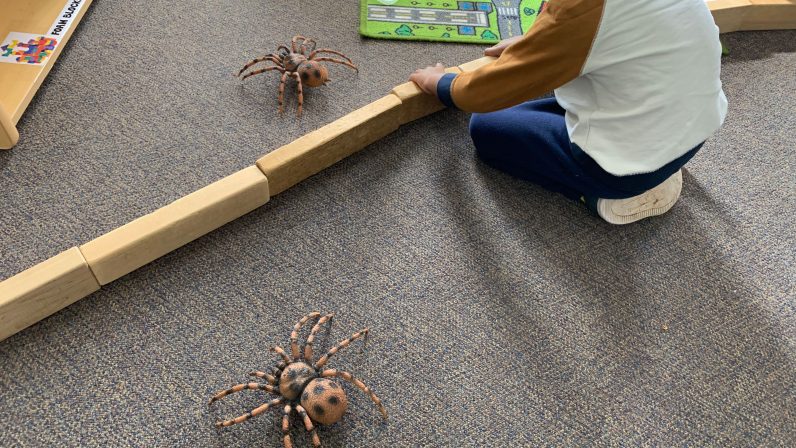During Monday’s all-school meeting, several classes reported news of emerging studies. It’s that time of year when deeper studies come forth, usually inspired by interests of children. I decided to investigate the roots of these studies, and it was no surprise how varied, yet similar, those roots are. Generally, studies have formulated based on observations, exploring the outdoor environment, responses to videos or books, favorite songs, solstice dances, and even state standards.
Observations in the Toddler 1s class have led them to a broad study of matching. Our littlest Seeds are learning through direct experience how things and people go together. They are exploring show shapes and sizes and number fit with one another. They are talking about friendships. It’s an organic, all-day approach.
Giant plastic spiders creep amongst the work of block builders in the Early 3s. Their recent study of dinosaurs morphed into a bug study when they discovered an assortment of living creatures in their outdoor garden area. First a moth, then a grasshopper, grabbed their attention. Their investigation developed further when they found leaf hoppers munching on garden produce. When I visited their classroom they were busily at work at the art table creating their own unique bugs, using purple paint, egg cartons, and piles of glitter. Books and songs about creepy crawlers with undoubtedly keep this study alive in the coming weeks.
Preschool 4s students have been involved in the democratic process to determine their big study of the year. After vetting several topics, students were given a homework assignment to vote on their top two choices. African safari animals was the winner. Maps and books are being introduced in the classroom now and the children’s questions are being recorded. Animal videos help inspire more questions, as the direction of the study comes into focus. Children spend time sorting classroom bins of plastic animals, separating out those appropriate for the study. As children sort, explore, and ask preliminary questions, the teachers look for ways to incorporation foods and cultural aspects of people like the Masai, and at the same time draw on expertise of parents with relevant knowledge. Introduction of the honey guide hummingbird in the days ahead will bring the meaning of new vocabulary like “symbiotic” to four-year-old minds.
In other classes where deep studies are forming, I’ve noticed a change I hadn’t seen before. It’s typical when a study starts to make a chart that lists:
• what we know
• what we wonder about
• what we’ve learned
The change I observed was instead of listing “what we know,” the charts read, “What we think we know.” This is a significant refinement, in my opinion. It honors the idea holder and, at the same time, invites greater precision in thinking and language. This kind of refinement is what our work at the Seed is all about. I credit each and every teacher for continuing attention to detail in this way, as deep studies unfold during this fruitful time of year.

